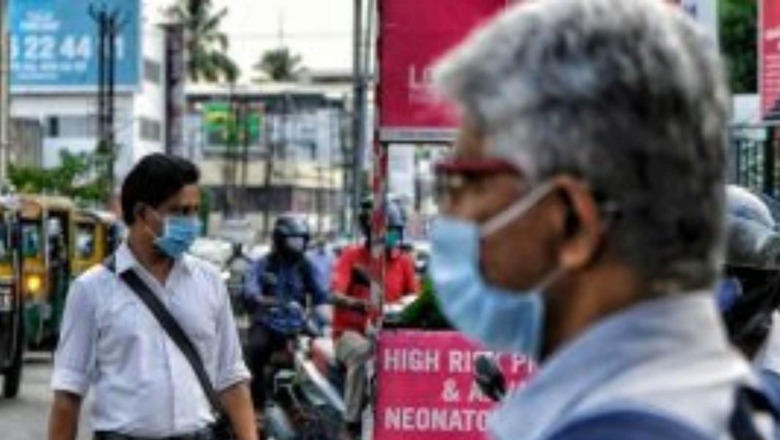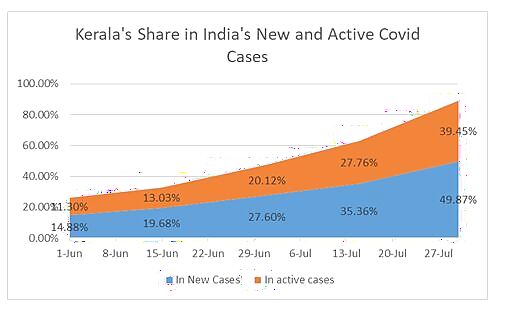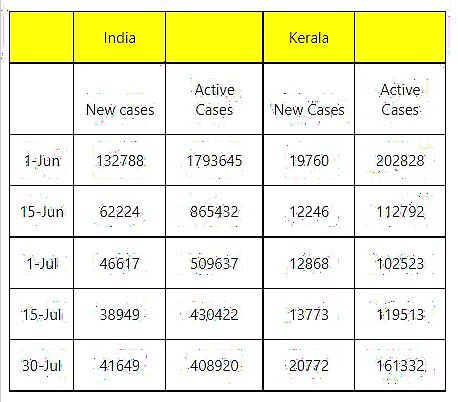
views
Active cases in Kerala, which were declining throughout the month of June, have started increasing rapidly now, especially after the Eid-ul-Azha festivities during which the state government relaxed its coronavirus-related public restrictions.
On comparing Kerala’s Covid numbers with India’s figures in the months of June and July, one finds that the southern state has been the main reason behind the slowdown in the decrease of the active caseload burden in the country. On June 1, Kerala’s share in India’s new and active caseload burden was 14.88% and 11.30% respectively. Since then, it has seen a consistent increase, first slowly and then rapidly.

On June 15, the state’s share in new and active caseload burden was 19.68% and 13% respectively, which increased to 27.60% share of new caseload burden and 20.12% of active caseload burden on July 1; 35.36% share of new caseload burden and 27.76% of active caseload burden on July 15; and 49.87% share of new caseload burden and 39.45% of active caseload burden on July 30.

In the last two months, though Kerala saw declining new and active cases initially, a 15-day analysis of the state’s Covid-19 numbers in the last two months says the fall soon gave rise to an increase and then a surge.
Between June 1 and 15, active caseload burden decreased by 44%. It slowed down to 9% between June 15 and July 1 and since July 1, it has seen a consistent increase. Between July 1 and 15, active caseload burden increased by 16.57% while it has seen a massive increase of 35% in the last fortnight.
Well into the phase of another crisis, reveals Kerala’s R-Value
The R-Value or the reproductive number or the effective transmission rate tells how fast the coronavirus spreads from one person to another. The R-Value must be less than 1 for the pandemic to end. India saw its lowest R-Value, at 0.78, around June 16 from the peak of 1.37 between March 9 and April 11 as analysed by IMSC, Chennai, a mathematical sciences institute. But is again up at 0.97 and rising continuously, according to an analysis published in The Print quoting IMSC’s numbers.
This is largely due to Kerala and the northeastern states driving India’s overall R-Value up.
As per IMSC, analysis, Kerala’s R-Value is 1.11 along with some northeastern states – Mizoram (1.27), Meghalaya (1.17), Sikkim (1.17) and Nagaland (1.09). But while northeastern states are small in population size, India’s Covid number is basically being pushed up by big states like Kerala and Tamil Nadu. Maharashtra, the state from where the second Covid wave began, is another crisis in making.
While Kerala is the biggest contributor right now, Maharashtra’s R-Value is now close to 1. Another Covid tracker, ‘Covid India Updates’, shows Tamil Nadu’s R-value at 0.99. In big cities, Delhi’s and Pune’s R-value has reached very close to 1 as per IMSC analysis.
As per Covid India Update tracker, Kerala’s R-value came below 1 on May 1 and remained in that zone till June 13, touching the lowest of 0.82. But after June 13, it has gone above 1 and has remained there. This shows why Kerala’s new cases have started increasing after around June 15 in the analysis done above, something that ultimately started reflecting in consistent increase in active caseload burden since July 1.
Low seroprevalence means more Keralites susceptible to coronavirus
ICMR recently released the results of the fourth nationwide serological survey giving state wise seroprevalence numbers. Seroprevalence means the share of population that already has antibodies against an infectious agent or coronavirus in this case. High seroprevalence number means more number of people with antibodies against coronavirus.
As per the survey findings, Kerala has the lowest seroprevalence number in India, at 44.4%. It means 55.4% of the people of the state are still susceptible to coronavirus infection. That reflects in the high test positivity rate of the state. Kerala’s Covid test positivity ratio has climbed to 13.61% against India’s national against the national daily test positivity rate of 2.34%. That is also one of the reasons behind Kerala’s high R-Value.
Seeing the surge, Kerala government has decided to impose a complete weekend lockdown on July 31 and August 1. Micro-containment zones are being created in each district with complete Covid restrictions. While Kerala has a case fatality rate (CFR) of 0.5%, that is much lower than the national Covid fatality rate of 1.34%, the surge in new and active cases if continued, will see the CFR going up, adding even more pressure to the overall national Covid burden.
Read all the Latest News, Breaking News and Coronavirus News here.




















Comments
0 comment